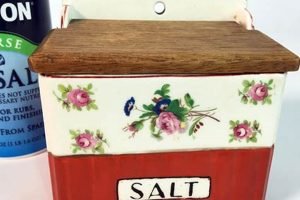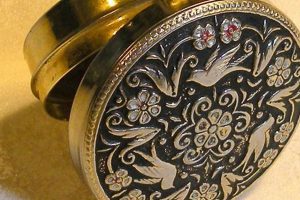These storage solutions, manufactured by the Kennedy Manufacturing Company, are characterized by their durable construction and distinctive design elements, often dating back several decades. They were widely used by machinists, mechanics, and other tradespeople to organize and transport tools. The product line encompasses a variety of sizes and configurations, typically constructed of heavy-gauge steel and featuring multiple drawers or trays.
The enduring appeal of these items lies in their robust build quality and association with a bygone era of American manufacturing. Their longevity and continued usability provide a practical solution for tool storage. Furthermore, they represent a tangible connection to the industrial heritage of the mid-20th century, making them sought-after items for collectors and enthusiasts alike. Their availability in the secondary market provides an accessible entry point for acquiring quality tool storage.
The following sections will delve into the specific characteristics, identifying features, restoration techniques, and market value considerations pertinent to understanding and appreciating these classic examples of tool storage design. These topics will provide a comprehensive overview for those interested in acquiring, restoring, or simply learning more about this particular category of vintage tool storage solutions.
Acquiring and Maintaining a Vintage Kennedy Tool Box
This section presents key considerations for those interested in acquiring or preserving a used Kennedy Manufacturing tool storage unit.
Tip 1: Assess Condition Carefully: Prior to purchase, thoroughly inspect the item for rust, dents, and evidence of prior repairs. Significant corrosion can compromise structural integrity. Check drawer slides for smooth operation.
Tip 2: Identify the Model: Researching the model number (often found on a label inside a drawer or on the back) provides information about original specifications and manufacturing dates. This aids in accurate restoration.
Tip 3: Evaluate Completeness: Determine if all original trays, dividers, and hardware are present. Missing components can impact usability and decrease value.
Tip 4: Address Rust Promptly: Surface rust should be treated immediately to prevent further damage. Use appropriate rust removal techniques, such as wire brushing or chemical treatments, depending on the severity.
Tip 5: Consider Repainting: If repainting is desired, use a durable enamel paint that closely matches the original color. Proper surface preparation, including sanding and priming, is crucial for a lasting finish.
Tip 6: Lubricate Moving Parts: Regularly lubricate drawer slides, hinges, and latches to ensure smooth operation and prevent wear. Use a light machine oil or silicone-based lubricant.
Tip 7: Preserve Originality: While restoration is acceptable, strive to maintain as much of the original character as possible. Avoid modifications that deviate significantly from the original design.
Adhering to these recommendations ensures the acquisition of a serviceable and historically significant piece, and contributes to its continued functionality and preservation for future use.
The subsequent section provides insights into market valuation and factors influencing the price of these desirable tool storage units.
1. Durability
The enduring popularity of this category of tool storage solutions is inextricably linked to the inherent durability of their construction. The Kennedy Manufacturing Company consistently employed heavy-gauge steel in the fabrication of their tool storage units. This material choice directly contributes to their resistance to dents, bending, and other forms of physical damage commonly encountered in demanding workshop environments. The result is a product capable of withstanding decades of use, a primary factor influencing its desirability in the used market.
The practical significance of this durability is evident in the numerous examples of these tool storage units still in active service after many years. Mechanics, machinists, and hobbyists continue to rely on them to protect and organize their tools. The robust construction not only protects tools from physical damage but also resists environmental factors such as moisture, reducing the likelihood of corrosion. This reliability translates to a long-term cost savings for the user, as the need for replacement is significantly reduced. This is shown by the fact that many users consider a pre-owned product from Kennedy to be preferrable than purchasing a brand new storage from other manufacturers.
In summary, the remarkable durability serves as a cornerstone of the appeal of this category of tool storage solution. The use of heavy-gauge steel and robust construction techniques ensures longevity, making them a practical and cost-effective choice for both professionals and hobbyists. This attribute, coupled with careful maintenance, allows these units to maintain their functionality and value over extended periods, solidifying their place as a desirable commodity in the market for used tool storage.
2. Original Finish
The presence and condition of the original finish are critical factors in assessing the value and desirability of a used Kennedy tool storage unit. The finish, typically an enamel paint applied at the factory, serves not only as a protective coating against corrosion but also as a key identifier of the unit’s age and authenticity. Maintaining the original finish preserves the item’s historical character and minimizes the impact of subsequent modifications, an attribute particularly valued by collectors. The absence or significant degradation of the original finish, due to rust, scratches, or improper refinishing, generally diminishes the unit’s market value.
Examples abound where tool storage units with well-preserved original finishes command a substantial premium over those that have been repainted or heavily altered. Consider two identical Kennedy tool boxes from the same model year. The one retaining its original paint, showing only minor wear consistent with age, might fetch twice the price of a similar unit that has been repainted in a non-original color or with a modern paint formulation. This price difference underscores the significance attributed to originality. Furthermore, the original finish often provides clues about the unit’s history and usage patterns. For instance, areas of wear concentrated around the handle or drawer pulls can suggest the type of work the tool box was used for, adding to its narrative appeal.
In conclusion, the original finish represents a significant determinant of value and authenticity in the domain of Kennedy tool boxes. Its preservation contributes directly to the item’s historical integrity and collector appeal. Understanding the impact of finish condition enables buyers and sellers alike to accurately assess the market value and appreciate the significance of maintaining this key attribute. Proper care, including gentle cleaning and the avoidance of harsh chemicals, is essential for preserving the original finish and ensuring the long-term value of these iconic storage solutions.
3. Model Variation
The term “model variation” holds significant weight when assessing any vintage Kennedy tool storage unit. The Kennedy Manufacturing Company produced a diverse range of tool boxes and chests over its operational history, with distinct models catering to different trades and tool storage needs. These variations encompass differences in size, drawer configuration, material thickness, locking mechanisms, and aesthetic design elements. The specific model directly impacts the usability, storage capacity, and ultimately, the value of the unit. For example, a machinist’s chest, designed for precision instruments, will differ substantially from a roll-around mechanic’s cart in terms of drawer layout and overall dimensions.
Understanding model variations is crucial for accurate identification, restoration, and valuation. Model numbers, typically stamped or affixed to the unit, serve as a primary means of differentiation. Online resources, vintage catalogs, and collector communities provide valuable information about the specifications and production years of various models. This knowledge enables potential buyers to verify authenticity, assess completeness, and determine if the unit meets their specific storage requirements. Moreover, certain rare or highly sought-after models can command a premium in the collector’s market. The 520 is a classic example; its often looked for because of its depth, offering more storage.
In summary, the concept of model variation is integral to appreciating this specific brand and type of product. A thorough understanding of the diverse models produced by Kennedy Manufacturing is essential for informed purchasing decisions, accurate restoration efforts, and a comprehensive appreciation of the history and evolution of these tool storage solutions. Failure to account for model-specific characteristics can lead to misidentification, inaccurate valuation, and ultimately, dissatisfaction with the acquired unit. Recognizing and appreciating model variation allows users and collectors to connect with the historical and practical significance of these tool storage products.
4. Hardware Condition
The condition of the hardware significantly influences the overall value and functionality of a vintage Kennedy tool box. Original hardware, including drawer pulls, latches, hinges, and locking mechanisms, is essential for maintaining the authenticity and operational integrity of the unit. Damaged, missing, or replaced hardware detracts from its historical accuracy and may compromise its usability. For example, a broken latch renders a drawer insecure, while incorrect replacement drawer pulls diminish the unit’s original aesthetic appeal. Corrosion, a common issue in older tool boxes, can seize hinges and latches, impeding smooth operation. The presence of original keys for the locking mechanism is also a notable factor, often increasing the box’s value among collectors.
The restoration process frequently involves addressing hardware issues. Sourcing correct replacement parts can prove challenging, requiring diligent research and potential scavenging from other units. Cleaning and lubricating existing hardware is often sufficient to restore functionality. Severely corroded or damaged hardware may require professional restoration or replacement. An example can illustrate this; consider a Kennedy tool box where all the original drawer pulls are present but heavily tarnished. Cleaning and polishing these pulls would preserve the originality and significantly enhance the box’s appearance. Conversely, replacing them with modern, readily available pulls would be a less desirable option, particularly for those prioritizing historical accuracy.
In summary, hardware condition constitutes a critical aspect of the overall evaluation of a Kennedy tool box. Original, well-maintained hardware enhances the box’s value, functionality, and historical significance. Addressing hardware issues through careful restoration or sourcing correct replacements is essential for preserving the integrity and usability of these vintage storage solutions. Ignoring hardware condition can lead to diminished value and a compromised user experience. Therefore, a thorough assessment of the hardware is imperative when acquiring or restoring these items.
5. Rarity Factor
The “Rarity Factor” exerts a substantial influence on the valuation and collectibility of these tool storage units. The limited production runs of specific models, design variations, or special edition units directly contribute to their scarcity in the secondary market. This scarcity, in turn, drives up demand among collectors and enthusiasts, leading to increased market values. For instance, a Kennedy tool box produced for a specific industrial client with unique badging or color schemes commands a premium due to its limited availability. The absence of readily available replacements and the historical significance associated with these pieces contribute to their desirability. Furthermore, tool boxes in exceptional condition or retaining original documentation associated with their production further amplifies the rarity factor and enhances their collectibility.
The practical significance of understanding the rarity factor lies in its impact on investment decisions. Collectors and investors alike often seek out rare or limited-edition tool boxes with the expectation of future appreciation in value. Identifying these rare examples requires careful research, familiarity with Kennedy Manufacturing’s historical product line, and access to reliable market data. Auction results, online marketplaces, and collector communities provide valuable information about the scarcity and current market values of various models. Conversely, items that were produced in high volumes or lack distinguishing features typically have lower rarity factors and, consequently, lower market values. A collector interested in obtaining the 526 model may be in for a shock, discovering the high-demand and small supply for the box.
In summary, the rarity factor represents a key determinant of value within the realm of Kennedy tool boxes. Limited production runs, unique design features, and exceptional condition all contribute to scarcity, driving up demand and market values. Recognizing and assessing the rarity factor requires diligent research and an understanding of the brand’s historical product line. While challenges persist in accurately quantifying rarity and predicting future market trends, a comprehensive understanding of this factor is essential for making informed decisions in the acquisition, restoration, and collection of these tool storage units.
6. Provenance
Provenance, in the context of a vintage Kennedy tool box, refers to its history of ownership and use. It provides a narrative that can significantly enhance the item’s value and desirability, particularly among collectors. Establishing provenance involves tracing the tool box’s origins and documenting its past owners, uses, and any significant events associated with it.
- Documentation and Records
Written records, such as receipts, invoices, or letters, can provide concrete evidence of ownership and usage. For example, a Kennedy tool box accompanied by a bill of sale from a specific machinist or a letter detailing its use in a particular industrial setting significantly bolsters its provenance. The presence of such documentation enhances credibility and establishes a clear chain of ownership.
- Associated Tools and Contents
If the tool box retains some or all of its original tools, these can serve as indirect indicators of its provenance. The types of tools found within might suggest the trade or profession of the original owner. For example, a tool box filled with precision measuring instruments likely belonged to a machinist or toolmaker. The tools themselves may also bear markings or engravings that further link them to a specific individual or company.
- Markings and Modifications
Inscriptions, engravings, or modifications made to the tool box can provide clues about its past. A tool box with a machinist’s name engraved on the lid, or a company logo stenciled on the side, offers valuable information about its ownership and intended use. Modifications, such as custom-built dividers or added compartments, may reflect the specific needs of its owner, adding to its unique history.
- Anecdotal Evidence and Oral Histories
While not as concrete as written documentation, anecdotal evidence and oral histories can contribute to the overall narrative of a tool box’s provenance. Stories passed down through families or recollections from former colleagues can provide valuable context and insights into its past. However, such evidence should be corroborated whenever possible with other forms of documentation or physical evidence.
Establishing the provenance of a Kennedy tool box often requires investigative work and a combination of historical research and physical examination. The more complete and verifiable the provenance, the more valuable and desirable the tool box becomes. Provenance provides a tangible connection to the past, transforming a functional object into a piece of industrial history.
Frequently Asked Questions
The following section addresses common inquiries regarding the acquisition, valuation, and maintenance of Kennedy Manufacturing tool storage units. These responses aim to provide clarity and informed guidance for prospective buyers and owners.
Question 1: How can the age of a tool box be accurately determined?
Precise dating can be challenging. Model numbers, often stamped on the interior or exterior, can be cross-referenced with vintage Kennedy catalogs or online resources. Design features, such as handle styles, latch mechanisms, and paint colors, can also provide clues. Serial numbers, if present, may offer more specific information, though Kennedy Manufacturing did not consistently utilize them.
Question 2: What constitutes an “original” Kennedy tool box, and why is it important?
An “original” unit retains the factory-applied paint, hardware, and internal components, without significant modifications. Originality is important because it preserves the historical integrity of the item, increasing its value among collectors and enthusiasts. It also reflects the quality and craftsmanship of the original manufacturing process.
Question 3: What are the key factors that influence the market value?
Several factors influence market value, including the model’s rarity, condition of the paint and hardware, presence of original components, documented provenance, and overall aesthetic appeal. High-demand models in excellent condition command the highest prices.
Question 4: Is it advisable to repaint a rusted or damaged Kennedy tool box?
Repainting can improve the appearance and protect against further corrosion, but it can also diminish the box’s value if not done carefully. Prioritize preserving the original finish whenever possible. If repainting is necessary, use a durable enamel paint that closely matches the original color, and ensure proper surface preparation.
Question 5: Where can replacement parts be sourced?
Replacement parts may be found through online marketplaces, antique tool dealers, and collector communities. Sourcing original or period-correct parts can be challenging, but it is essential for maintaining the unit’s authenticity. Reproduction parts are also available, but they may not be exact matches.
Question 6: What are some essential maintenance practices?
Essential maintenance practices include regular cleaning with a mild detergent, lubricating moving parts (drawer slides, hinges, latches), and promptly addressing any signs of rust. Store the tool box in a dry environment to prevent corrosion. Avoid using harsh chemicals or abrasive cleaners, as these can damage the original finish.
In summary, informed decision-making is crucial when acquiring or maintaining one of these tool storage units. The answers provided aim to clarify key considerations and address common misconceptions.
The subsequent section explores case studies and real-world examples of Kennedy tool box restorations and collections.
Conclusion
This exploration of the vintage Kennedy tool box reveals a durable and historically significant piece of industrial design. These storage solutions, characterized by their robust construction, model variations, and potential for restoration, represent more than mere tool containers. The condition of the original finish, the rarity of specific models, and the documented provenance all contribute to an item’s value and desirability. Careful assessment of these factors allows for informed decisions regarding acquisition, maintenance, and preservation.
The vintage Kennedy tool box serves as a tangible connection to a bygone era of American manufacturing and craftsmanship. Its enduring functionality, coupled with its historical significance, ensures its continued relevance for both tradespeople and collectors. Continued study and appreciation of these items will preserve their legacy for future generations, serving as reminders of the value of durability, quality, and a connection to the past.







